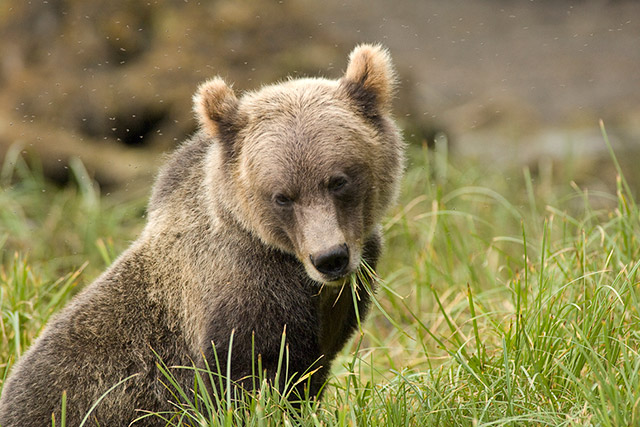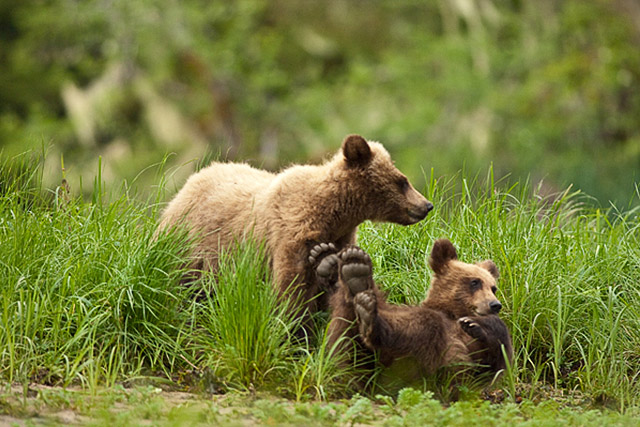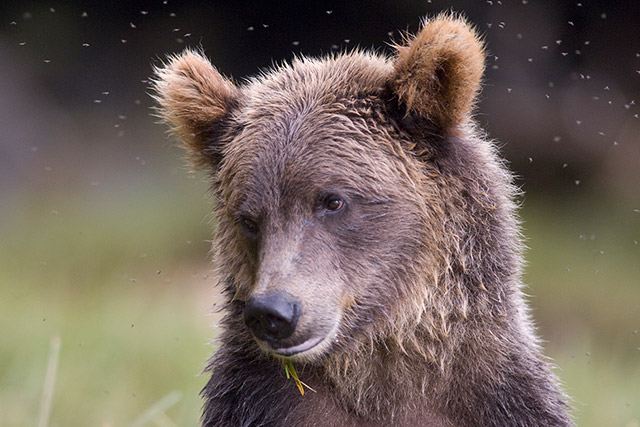|
| |
| 25. März 2013 |
Bericht der David Suzuki Foundation zur akuten
Gefährdung der Grizzlybären im Süden von BC |
| |
| Ein Bericht der David Suzuki Foundation von Jeff Gailus mit dem Titel „Securing a National Treasure: Protecting Canada’s Grizzly Bear“, der im März 2013 vorgelegt wurde, macht auf die akute Gefährdung der noch verbliebenen Grizzlybären-Populationen im Süden von BC aufmerksam und fordert den kanadischen Umweltminister Peter Kent auf, endlich zu handeln. Aufgrund der jahrelangen Untätigkeit des kanadischem Umweltministeriums und auch der Provinzregierung von BC ist zwischenzeitlich die Subpopulation der Grizzlybären im Garibaldi-Pitt-Gebiet gänzlich verschwunden. Weiteren Grizzlybären-Populationen im Süden von BC und im mittleren Landesteil droht ohne entsprechende Schutzmaßnahmen das gleiche Schicksal. Schon jetzt ist die Anzahl der Grizzlybären drastisch gesunken, z. T. sogar unter eine kritische Untergrenze, die ein Überleben einer lokalen Population gewährleisten könnte. „The situation is so dire that for a second time in 10 years, the country’s expert panel, the Committee on the Status of Endangered Wildlife in Canada (COSEWIC), has instructed the federal government to legally list and protect the animal under the Species at Risk Act“, schrieb Faisal Moola, Direktor der David Suzuki Foundation, am 14.3.2013 (Bringing grizzlies back from the brink demands political leadership). |
| |
 |
| Grizzlybär im Frühjahr beim Fressen von Seggen |
© Klaus Pommerenke |
|
| |
| Schon 2002 warnte das COSEWIC in Bezug auf die sinkenden Grizzlybär-Populationszahlen in BC und Alberta: „Bears living in portions of the southern fringe of Canadian distribution are far from secure from the consequences of burgeoning human populations and activities … The genetic and geographic continuity that now prevents their identification as distinct population units is at risk … Preventing the slow northward migration of this line depends on active steps to conserve these insulae and peninsular populations.“ Damals galten Grizzlybären nur als „species of special concern“ und noch nicht als „endangered species“. Zehn Jahre lang – unter fünf verschiedenen kanadischen Umweltministern – geschah nichts zum Schutz der Grizzlybären. Sie sind immer noch nicht als bedrohte Art im Species at Risk Act (SARA) aufgelistet. Im Bericht des COSEWIC von 2012 heißt es zu den Grizzlybär-Populationen: „… their poor condition in some parts of the range, combined with their natural low reproductive rates and increasing pressures of resource extraction and cumulative impacts in now intact parts of the range, heighten concern for this species if such pressures are not successfully reversed.“ Seit diesem COSEWIC-Bericht hat die Provinzregierung von BC (unter deren Verantwortung der Wildtierschutz größtenteils fällt) lediglich für eine von neun als bedroht eingestuften Grizzlybär-Subpopulationen einen „Schutzplan“ (einen sogenannten recovery plan) entwickelt, diesen jedoch nicht umgesetzt. So bleibt auch die North Cascade-Population der Grizzlies bislang ohne entsprechende Schutzmaßnahmen. „During the same period, new research found the grizzly bear population in the South Coast Mountains has been fragmented into several small population isolates, some as small as 20 animals. One of these – in the Garibaldi-Pitt Grizzly Bear Population Unit just north of Vancouver – has all but disappeared. And yet industrial and urban development in Grizzly Bear habitat continues a pace, increasing the risk of further declines … Given the severity of currant threats to the grizzly’s survival, and lack of action at the provincial level, it is imperative that Canada’s Conservative government list the grizzly bear on Schedule 1 of the Species at Risk Act“, schrieb Jeff Gailus am 14. März in der Vancouver Sun (Grizzly bear deserves protection. Encroachment on habitat in Western and Northern Canada threatens to push species into at-risk territory). |
| |
 |
| Junge Grizzlybären beim Spielen |
© Klaus Pommerenke |
|
| |
| Doug Neasloss, Chef des Kitasoo/Xaixais Band Council von Klemtu im Great Bear Rainforest erklärte: „First Nations have shared the land with bears for thousands of years … We not only revere the animal in our culture but also depend on it as part of the sustainable tourism industry we’re trying to create so that people from around the world can come to see bears in the wild. We must implement legislative measures to protect and recover grizzly bears before it’s too late.“ |
| |
 |
| Karte mit bedrohten Grizzlybär-Populationen in BC und Alberta und mit Gebieten, in denen die Grizzlybären bereits ausgerottet sind |
© David Suzuki Foundation, Securing a National Treasure:
Protecting Canada’s Grizzly Bear, Jeff Gailus, März 2013 |
| |
Nachfolgend finden Sie eine Zusammenfassung wichtiger Ergebnisse der Studie der David Suzuki Foundation (Backgrounder zur Pressemeldung „Grizzly bears deserve immediate legal protection in Canada“ vom 13. März 2013). Die gesamte Studie ist online verfügbar unter
www.davidsuzuki.org/publications/downloads/2012/DSF_grizzly_March_2013_web_2.pdf |
| |
| Backgrounder: Securing a National Treasure – DSF report on Canada’s grizzly bears |
- B.C. and Alberta are the only two provinces in Canada without a stand-alone Endangered Species Act, leaving the bears without protective legislation.
- In 2002, the Committee on the Status of Endangered Wildlife in Canada (COSEWIC), an independent group of wildlife experts and scientists that reports to Ottawa, concluded that the grizzly was a species of "special concern" and warned that populations were in peril in southern Canada.
- In its 2012 assessment, COSEWIC came to a similar conclusion, noting that a number of populations in the southern range in Alberta and southern B.C. are declining. The assessment states, "their poor condition in some parts of the range, combined with their naturally low reproductive rates and increasing pressures of resource extraction and cumulative impacts in currently intact parts of the range, heighten concern for this species if such pressures are not successfully reversed."
- In Canada there are 16 subpopulations – nine in B.C. – on the cusp of extinction due to residential, agricultural, recreational and industrial activity. Such development slices grizzly territory into little islands that are insufficient to support the bears’ need for large tracts of land while leaving them highly vulnerable to poachers and vehicle collisions.
- In total, B.C. has about 15,000 grizzlies. The healthiest populations are in the north central and northern regions of the province.
- In Alberta, about 760 grizzlies are left. This tiny group is becoming increasingly fragmented into islands of populations due to human encroachment. This contraction of territory isolates bears and prevents them from finding mates while exposing them to poaching, human-bear conflict, declining food sources and vehicle accidents.
- Scientists believe that the Alberta grizzly is in decline.
- Road construction puts grizzlies at extreme risk of being killed as poachers utilize back roads for their illegal killing sprees. Studies show that most grizzlies are killed within 500 metres of a roadway.
- Scientists estimate that hundreds of grizzly kills every year go unrecorded, victims of illegal shooting, human-bear conflict and vehicle accidents.
- Roadways are avenues of death for grizzlies. Studies show that 89 per cent of human-caused grizzly mortalities occur within 500 metres of a road on provincial lands.
- One hundred per cent of human-caused mortalities in national parks occur within 200 metres of a trail.
- Death from hunters most often occur close to roadways.
- Grizzly bear survival rates decrease in proportion to increasing access to their territory by motorized vehicles.
- More grizzly bear females are killed along roads than grizzly bear males. This is a significant problem for population stability.
- The International Union for the Conservation of Nature, the world’s largest global environmental organization, has established that wildlife populations smaller than 250 mature breeding adults should be listed and managed as endangered.
- In B.C., where subpopulations are formally identified as Grizzly Bear Population Units, or GBPUs, the following groups were classified back in 1995 as "threatened." However, nothing has been done to return them to "viable" status except for the suspension of hunting. Unsustainable levels of human activity have pushed Canada’s southern grizzly bear subpopulations to the brink of extinction.
- In the South Selkirk GBPU, a group of 58 bears eke out a living, corralled by highways and development.
- The South Purcell GBPU has only 92 remaining bears.
- In the Yahk GBPU, only 20 bears remain.
- The Stein-Nahatlach GBPU is home to 24 bears.
- The Garibaldi-Pitt grizzly population, which earlier this year hosted two bears, is now extinct.
- The Blackwater-West Chilcotin is home to 53 grizzlies.
- The Kettle-Granby GBPU has 86 bears.
- The North Cascades GBPU has a mere six grizzlies.
- The South Chilcotin Range GBPU includes several smaller, isolated groups that are the most genetically isolated grizzly bear families in North America. Altogether, there are an estimated 203 adult grizzlies prowling this rugged terrain.
- Another six GBPUs have such low populations that hunting isn’t allowed. However, studies show that grizzly deaths still occur due to poaching and human-bear conflict.
- Ineffective application of different levels of legislation in Canada has left species under threat with no protection. Neither Alberta nor B.C. has endangered species legislation. The federal government has shown reluctance to use the Species at Risk Act’s safety net provision to protect species on provincial lands when provincial governments have refused to do so, leaving grizzlies in legislative limbo.
- The United States Endangered Species Act has given the U.S. Fish and Wildlife Service the power to initiate successful population recovery and habitat management strategies. Thousands of kilometres of roads were closed and fines levied against backcountry users. Hunters, ranchers, landowners and First Nations cooperated to stop grizzly bear killings. The results were spectacular. From a low of 200 in the Greater Yellowstone Ecosystem, grizzlies now number 600 and are increasing by five per cent a year. The Northern Continental Divide in northwestern Montana has grown from 300 individuals to more than 750 bears today with an annual growth rate of three per cent.
|
 |
| Grizzlybär |
© Klaus Pommerenke |
|
| |
 zurück zurück |
|
|

